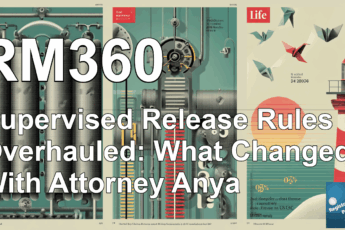When it comes to the legal maze that defines the criminal justice system, few topics carry the weight of the constitutional right to a speedy trial. This right, fundamental to preserving justice, is upheld by tools like the Serna motion in California. But what does this legal mechanism entail, and why are its implications so crucial for defendants? Today, we’ll dive deep into Serna motions, their relationship with the Sixth Amendment, and how delays in the justice system can impact outcomes—for better or worse.
Guided by insights from seasoned criminal defense attorney, Chance Oberstein, and sparking an occasionally witty dialogue, we’ll break down what you need to know about Serna motions, real-world examples, and how they can work to a defendant’s advantage—or disadvantage.
What Is a Serna Motion, and Why Does It Matter?
To paraphrase Chance Oberstein, a Serna motion is the legal world’s way of calling out the justice system for ghosting a defendant. This motion, specific to California, empowers defendants to request the dismissal of criminal charges when the prosecution takes an unreasonable amount of time to move the case to trial. Think of it as the Constitution’s way of saying, “Hey, don’t leave people hanging!”
The legal backbone of this argument comes from the Sixth Amendment of the U.S. Constitution, which guarantees the right to a speedy trial, and California Penal Code § 686 sub. 1, which backs it up locally. Without this safeguard, defendants could be left waiting indefinitely, with their lives and reputations hanging in the balance.
But it’s not just a fancy legal declaration. As Oberstein explains, “Justice delayed can turn into justice denied,” especially when fading memories, lost evidence, and unavailable witnesses threaten a defendant’s ability to mount a fair defense.
Too Long of a Wait: Setting Standards for Delays
So what qualifies as “too long” when we talk about delays? The landmark case of Serna v. Superior Court (1985) set the standard. According to this ruling:
- Delays exceeding one year for misdemeanors or three years for felonies are presumed unreasonable.
When the delay crosses this threshold, the burden of proof shifts to the prosecution. They must justify the delay by demonstrating sufficient reasoning or extenuating circumstances. If they can’t, the case may be dismissed in a flash—faster than you can say “statutory violation.”
Oberstein adds that this isn’t a free pass. The government can’t simply play the “oops, we forgot” card and expect leniency. He cites Doggett v. United States (1992), where the U.S. Supreme Court declared that government negligence, like forgetting to file charges or losing track of a case, doesn’t excuse violating a defendant’s right to a speedy trial. “If the government drops the ball,” Chance emphasizes, “it’s on them, plain and simple.”
The Barker Balancing Test: Weighing the Factors Behind Delays
However, not all delays are equal, and courts use nuanced frameworks to determine whether a delay is permissible. One key tool is the Barker v. Wingo balancing test, established in 1972. This “legal checklist” relies on four key factors:
- Length of the delay – Is it beyond what is reasonably allowed for the complexity of the case?
- Reason for the delay – Was it caused by unavoidable circumstances, such as court backlogs, or preventable negligence?
- Defendant’s assertion of their right – Did the defendant actively invoke their right to a speedy trial?
- Prejudice to the defendant – How has the delay impacted the defendant’s ability to mount a fair defense (e.g., memories have faded, evidence lost)?
Chance likens it to creating a pros and cons list with high stakes. Each factor is carefully weighed before the court determines whether the delay warrants dismissing a case.
Real-World Example: A Case Dismissed in Orange County
The power of a Serna motion can be seen in concrete cases. Consider a striking example that unfolded in Orange County, California:
In 2019, a defendant was charged with vehicular vandalism on September 16. Fast forward over three years—January 15, 2024—and the prosecution finally issued an arrest warrant. During this time, the defendant had been living at the same address, unaware of the pending charges.
The delay was egregious, so the defendant’s attorney filed a Serna motion, arguing the speedy trial rights were violated per Serna v. Superior Court and Doggett v. United States. The court agreed with the defense, ruling the delay unjustifiable. The case was dismissed, and the defendant walked free—a clear victory for justice.
The Devastating Impact of Delays on Defendants
While beneficial outcomes like the Orange County case may occur, delays typically work against defendants in significant and harmful ways. Oberstein outlines some of the common challenges:
- Fading Memories: Witnesses may forget crucial details over time, weakening their testimony.
- Lost Physical Evidence: Documentation or items that could support the defense may deteriorate or go missing.
- Witness Availability: Key witnesses may move away, pass away, or otherwise be unavailable after a lengthy delay.
In short, delays can become a legal nightmare, depriving defendants of the ability to argue their case effectively.
Steps for Defendants to Take When a Case Drags On
If you think your case has been delayed unreasonably, what should you do? Oberstein offers some valuable advice:
- Hire an Experienced Defense Attorney: This is critical. Skilled attorneys can identify whether your speedy trial rights were violated and determine if a Serna motion is appropriate.
- Track Key Dates and Evidence: Document the timeline of your case from when the alleged offense occurred to when charges were filed. This creates the foundation for your motion.
- File the Serna Motion: Your attorney will submit the motion to the court under California Penal Code § 686 sub. 1. A hearing date will be scheduled for review.
Knowing local nuances (e.g., different filing deadlines in various counties) is also essential to avoid missteps.
When Delays Work in a Defendant’s Favor
Interestingly, there are instances when delays benefit defendants. For example:
- Weakened Prosecution: If the case relies heavily on witness testimony, fading memories over time can make it impossible for the prosecution to build their case.
- Degraded Evidence: Physical evidence that’s critical for the prosecution may no longer hold weight, giving the defense an upper hand.
As noted by Larry, a co-host in the discussion, sometimes delays align with the defense’s strategy. “The longer the case drags on, the more chances for the prosecution to lose a witness or mishandle evidence,” he remarks. A skilled attorney can use these situations to negotiate better outcomes, such as reduced charges or favorable plea deals.
When to Seek a Second Opinion on Your Case
Finally, what if you feel your current attorney hasn’t properly addressed delays in your case? Oberstein assures defendants that seeking a second legal opinion is always an option: “Sometimes a fresh set of eyes can uncover opportunities that were previously overlooked.”
While some attorneys hesitate to give second opinions, it’s essential to know your rights. If you feel your current representation isn’t exploring all potential advantages, don’t hesitate to consult a new attorney to reexamine your case.
Takeaways: Protecting Your Speedy Trial Rights
The right to a speedy trial isn’t just a legal technicality—it’s a safeguard of fairness. Here’s what to remember if you or someone you know faces a delayed criminal case:
- Understand Your Rights: Delays exceeding one year (misdemeanors) or three years (felonies) are likely unreasonable.
- Act Quickly: Work with an experienced defense attorney to evaluate and file a Serna motion if applicable.
- Be Proactive: Gather evidence showing how delays harmed your case or created prejudice against your defense.
With the right legal expert and strategy, a delay doesn’t have to spell doom for your case—it just might result in justice served.
In the end, as Oberstein reminds us, the Constitution isn’t just a set of principles; it’s the cornerstone of guaranteeing fairness, accountability, and justice—especially when clocking delays in the courtroom.





Leave a Comment